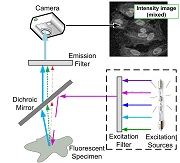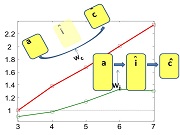Yoav Y. Schechner: Research
Multiplexed Fluorescence Unmixing

Multiplexed imaging and illumination have been used to recover enhanced arrays of intensity or spectral reflectance samples, per pixel. However, these arrays are often not the ultimate goal of a system, since the intensity is a result of underlying object characteristics, which interest the user. For example, spectral reflectance, emission or absorption distributions stem from an underlying mixture of materials. Therefore, systems try to infer concentrations of these un- derlying mixed components. Thus, computational analysis does not end with recovery of intensity (or equivalent) ar- rays. Inversion of mixtures, termed unmixing, is central to many problems. We incorporate the mixing/unmixing pro- cess explicitly into the optimization of multiplexing codes. This way, optimal recovery of the underlying components (materials) is directly sought. Without this integrated ap- proach, multiplexing can even degrade the unmixing result. Moreover, by directly defining the goal of data acquisition to be recovery of components (materials) rather than of in- tensity arrays, the acquisition becomes more efficient. This yields significant generalizations of multiplexing theory. We apply this approach to fluorescence imaging.
Publications
- Marina Alterman, Yoav Y. Schechner and Aryeh Weiss, “Multiplexed Fluorescence Unmixing,” Proc. IEEE ICCP (2010).
Presentations
- “Multiplexed Fluorescence Unmixing” (2.3 Mb, PowerPoint)




